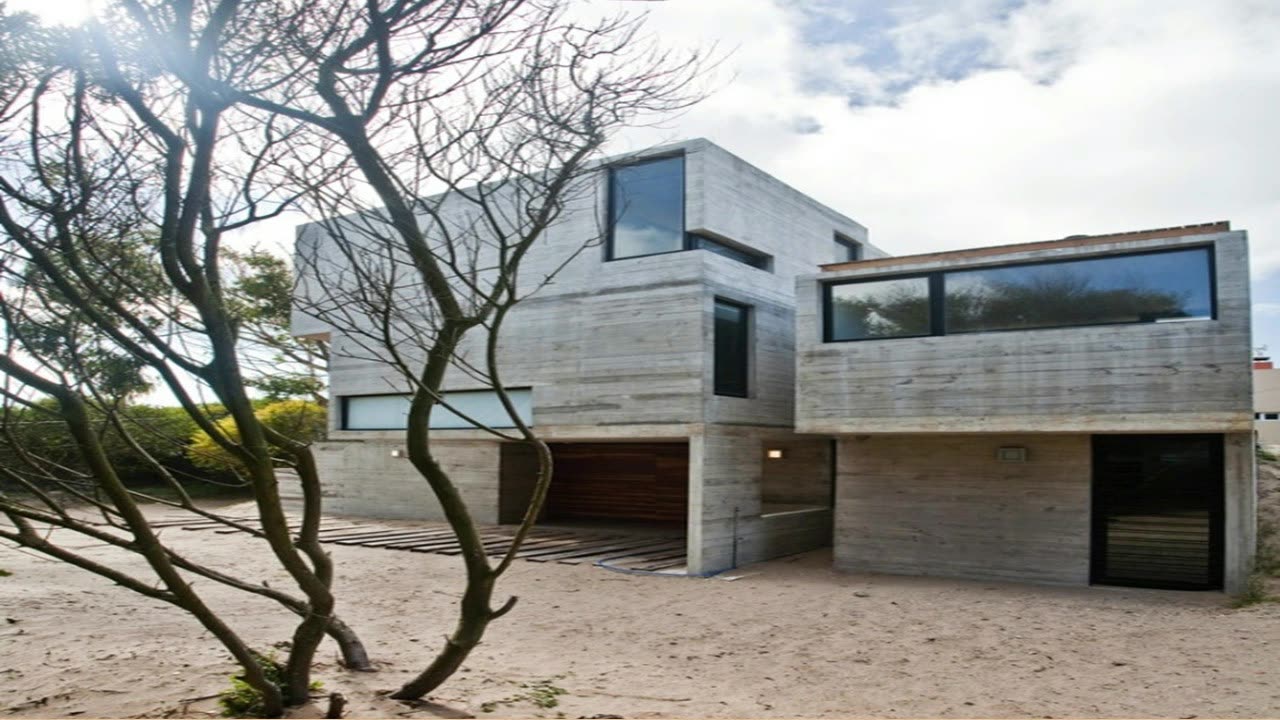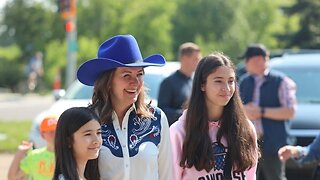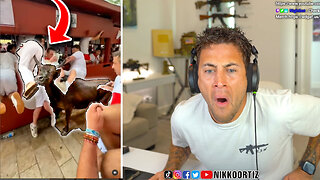Premium Only Content

Welcome to BAK Arquitectos' House On The Beach
Welcome to BAK Arquitectos' House On The Beach
HOUSES•VILLA GESELL, ARGENTINA
Architects: BAK arquitectos
Area: 950 m²
Year: 2009
Photographs: Guillerme Morelli
The Place: The land of 20mx47m where we have to intervene is placed a few meters away of the dune wherethe beach ends. In spite of it, the land is near a house of big size which clogs in some parts the views to the sea.The rest of the views, free of near buildings, allows the enjoyment of smallvegetation, acacias and tamarinds, that overlooks the sea on one side and the forest insinuates on the other. The land has the particularity to present, in the center and along its length, a 3 meters crest elevation in relation to their sides. This singularity and the need to elevate the building over the natural line of the lot to gain sea views were fundamental issues in the proposal.
The commission: The clients, a young couple with 3 little children, arrived to ourstudy asking for a house of concrete -as it seems to has a lowmaintenance and we love the design of the others houses you have already made - they said – we need a big house with five or six bedrooms and large spaces of meeting but to berealized in two stages – they add. We suggest that, as the existing regulations allows it they can consider building two different housing units, one of them the principal house in a size that allows us to built it in one stage and then another for guests. Satisfied with this proposal and with the aesthetic and constructive solution that the studio had already done in the forest, the clients only conditioned the project requiring us that we should take advantage out of this location so close to the beach to enjoy the sea views from the main rooms of the house, as well as from its expansions.
The program: The commission for the first stage was a house with a main bedroom with bathroom en suite, two bedrooms to the sons with a shared bathroom and a service bedroom for guests, with its own bathroom. It was also required adining room with integrated kitchen, grill and expansion terrace, a semi-covered garage and an enclosed place to be used as a general deposit and for saving the quadricycle.
The proposal: We focus our search for solutions trying to accommodate this program to this topography and particular environment, looking for gaining views to the sea without making significant changes to the dune. In relation with thepath of the sun and the dominant winds, the house must be open to the NE and control its openings to the SO. The lateral facade to the SE, despite of been exposed to strong rains and winds, should have big openings to provide views to the sea. With this premises and working in the transversal section of the land, we note that if we put the principal floor plan of the house like a prism perpendicularly over the crest of the dune, we reach, in one end, views to the sea, while in the other end and under it, we can create an access plan at the same level of the street; and in the same place but over the principal prism we could create another floor which can be the main bedroom and its bathroom with a big terrace providing generous views to the whole land. Decided that the stairway, which logically organizes the three levels, was transformed into a leading place, hence its strategic location and its studied spatial treatment with an emphasis on light entrance and the views generated in its path. The proposed afforestation, following the principle of minimum intervention in the landscape consisted of projecting retaining walls of quebracho sleepers to help contain the dune to allow the regrowth of the zone’s pastures.
The functional organization: After saving the difference of height between the street and the access level with the help of wood planks, it is accessed to the house by a semi-covered (which can be used as a garage) where a quebracho tables’ wall is highlighted formed by the gateway that closes the storage and also the entrance door. In this level it is placed a small hall, the guestroom with its bathroom and the internal entry to the storage and the laundry. Going up the stairs between concrete walls you get to the main floor of the house. It has a living room with integrated kitchen, with expansions to the front and the back of the lot, and two bedrooms for the children with a bathroom for this level. In parallel to the first staircase develops the stairs leading to the top floor of the house. By this one, you reach a small hall from which you can access a large terrace to the front and one to the back, and also the main bedroom with bathroom en suite. This room has outstanding views towards the beach and through a generous opening can go out to the main terrace from which one can enjoy views of the whole landscape.
The structural solution: The entire house is solved by reinforced concrete partitions and slabs. The versatility of this constructive system allows us to solve the important overhang of the semi-covered access as it doesn’t have any support in one of its extremes, as we consider relevant for the project that the three levels of the house were not expressed in the front. We also use a significant cantilever on the opposite end, where the dune falls abruptly, so that the house lean without altering its natural profile.
The construction: It was used the same concrete of the other works in Mar Azul (H21 with fluidizer) a mixture with low amount of water that when forge create a concrete with a lot of compactness. As a result of this process, it is not necessary to employ any kind of facing,achieving a lowbudget in its terminations and a minimum or non posterior maintenance. The adaptation of the constructive system used in the forest for this place, consist in the use of “decks as umbrellas”. They are made by braces of wood seated to the slab on which the tables rely so that between them and the concrete ceiling is a space through which air flows. On the other hand , to improve the thermal insulation of the exterior walls it was build, in the interior part, a wall of air bricks revoked and painted, and also it was thought, in the whole locals, cross ventilation to make the maritime winds cool in the days of high temperature and to avoid using air conditioning system.The openings are made by aluminum; it was used open windows instead of sliding windows in order to avoid the accumulation of sand in the guides, and it was used double glass with air chamber to optimize the thermal insulation. The heating system, because of the fact that there is not natural gas in the zone, was resolved with a system that agreed salamander, bottle gas stove and electrical resistances. The whole interior septums are made by air-bricks revoked and painted with white latex. The bathrooms have ceramic facings in the walls which are not made by reinforced concrete. The floor is made by smooth cement divided by aluminum’s planks. The encounter between walls and floor was resolved with an aluminum profile as a socle.
Furniture: It was design by the study; it is an agreed between immobile furniture made of concrete and mobile furniture made of recovered Canadian wood pine which comes from boxes of package’s engines. The table (resolved like a slab united to the septum which divides the kitchen and the living room), the closets, and the woodshed are made of concrete.
-
 4:22
4:22
Michael Heaver
2 hours agoLabour Make DISGUSTING Decision Against England
441 -
 1:05:42
1:05:42
Lara Logan
15 hours agoINSIDE THE MAR-A-LAGO RAID with Trump Attorney Christina Bobb | Episode 33
17.3K2 -
 1:38:45
1:38:45
Steven Crowder
4 hours agoAI Celebs Just Scammed Women out of Millions & Premium Interview w/ Patrick Christys
201K148 -
 43:48
43:48
The Mel K Show
3 hours agoMORNINGS WITH MEL K -This Labor Day Celebrate Liberty, Freedom & Family! 8-29-25
14.2K1 -
 59:02
59:02
The Shannon Joy Show
4 hours ago🔥🔥The Butchers At Hilo Benioff Hospital Hawaii - Mom Subjected To Forced C-Section & Abuse🔥🔥
20.1K2 -
 41:26
41:26
daniellesmithab
2 hours agoBetter, Faster, Smarter Access to Government Services
8.06K3 -
 LIVE
LIVE
LFA TV
7 hours agoLFA TV ALL DAY STREAM - FRIDAY 8/29/25
2,906 watching -
 44:41
44:41
Grant Stinchfield
20 hours ago $1.11 earnedEven DC’s Homeless Beg for Trump’s Law & Order — While Wacky White Liberal Women Scream NO!
16.1K3 -
 1:02:30
1:02:30
VINCE
5 hours agoGavin Newsom Is A Major Trump Fan | Episode 114 - 08/29/25
195K166 -
 1:32:10
1:32:10
Nikko Ortiz
4 hours agoPainful Life Experiences
37.4K12